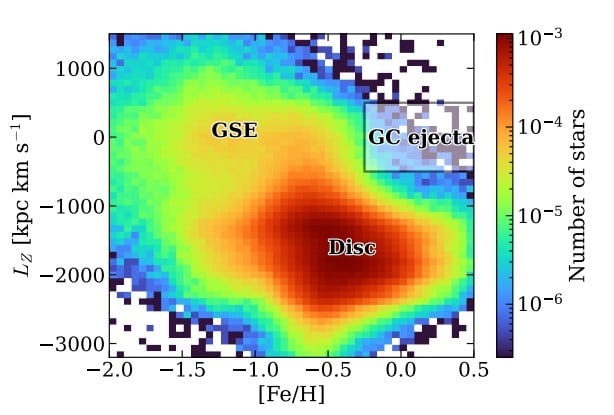We know black hole mergers occur because we can detect the resulting gravitational waves. But when trying to piece together the history of black holes mergers in the Milky Way, astronomers need another tactic. They need to perform some forensic astronomy.
Astronomers think that supermassive black holes (SMBH) with up to billions of solar masses likely sit at the center of all large galaxies like the Milky Way. They also know of about 50 candidate or confirmed stellar mass black holes with tens of solar masses in the Milky Way, and there are likely tens of millions more of them. Intermediate mass black holes (IMBH) are in between the other two categories and have up to one hundred thousand solar masses, though they remain candidates at this point.
An obvious conclusion is that they're all related and that SMBHs like Sgr A* in the Milky Way become so massive through a long sequence of mergers. When trying to piece together the Milky Way's SMBH merger history, astronomers need to get creative. New research probes the merger history by searching for stars ejected from the Galactic Center (GC).
The research is "Searching for stars ejected from the Galactic Centre in DESI," and it will be published in Astronomy and Astrophysics. The lead author is Sill Verberne from the Leiden Observatory at Leiden University in the Netherlands. The paper is currently available at arxiv.org.
DESI is the Dark Energy Spectroscopic Instrument, a telescopic instrument attached to the Mayall Telescope at the Kitt Peak Observatory in the US. DESI is undertaking a massive spectroscopic survey aimed at understanding the expansion history of the Universe and what role dark energy physics plays. The new research combines DESI data with Gaia data to probe stellar populations in the halo, especially stars that were ejected from the Galactic Center.
Astronomers know of many hypervelocity stars ejected from the GC through interactions with Sgr A star. They travel at hundreds to thousands of km/sec. But the researchers wanted to find other stars ejected from the GC that are travelling at slower speeds. They can be ejected during black hole mergers, and their presence in the stellar halo would provide clues to Sgr A star's merger history.
It's not easy spotting these stars in the halo. The stellar halo is the visible part of the galactic halo, and is a complicated region made up of substructures like the remnants of smaller galaxies that have been absorbed. Different stellar populations with different origins have different metallicities. Some of them also have different kinematics. So while the stellar halo contains clues about the Milky Way's history, those clues are obscured.
The researchers searched for ejected stars by filtering for both velocity and metallicity.
"In this study, we use the first data release of DESI to search for these slower GC ejecta, which are expected to stand out from the stellar halo population for their combined high metallicity ([Fe/H] ≳ 0) and small values of their vertical angular momentum (LZ)," the authors write. Their goal is to constrain the population of GC ejecta that has built up in the halo over billions of years.
"No other stellar halo populations are known with metallicities similar to the GC, making the metallicity a crucial factor in the identification of this population of stars," they authors explain.
 This figure is a histogram of metallicity (Fe/H) and Lz (vertical angular momentum) for stars in the DESI data. Areas occupied by different galactic components and GC ejecta are highlighted. Image Credit: Verberne et al. 2025. Astronomy and Astrophysics.
This figure is a histogram of metallicity (Fe/H) and Lz (vertical angular momentum) for stars in the DESI data. Areas occupied by different galactic components and GC ejecta are highlighted. Image Credit: Verberne et al. 2025. Astronomy and Astrophysics.
The researchers' first step was to simulate a population of ejected GC stars. That gave them a footprint with which they could recognize these stars in the data from DESI and Gaia. Then they needed to identify this population of stars, while also understanding that other populations unrelated to GC ejections also occupy some of the same parameter space. These are the stellar remnants from the Gaia-Sausage/Enceladus dwarf galaxy and the Splash.
"In this work, we investigated whether we could identify an overdensity of high-metallicity stars at low angular momenta in the Galactic halo using data from DESI DR1," the authors write in their conclusion. "Such a population could point to Hills mechanism disruptions of binary stars near Sgr A star or past mergers of Sgr A star with intermediate mass or massive black holes." (The Hills mechanism disruptions refers to a binary star disrupted by interactions with a supermassive black hole.)
The team found no stars in the halo that came from past SMBH mergers involving Sgr A star. While in many scientific endeavours a non-detection feels like a failure, in this case it's not. The research is aimed at constraining the population of these stars, and zero is a strong constraint.
"Our analysis yields a non-detection that we use to constrain the GC ejection rate over a timescale of ∼ 5 Gyr," the authors write. "Specifically, we conclude that the average ejection rate over the past ∼ 5 Gyr cannot exceed ∼ 2.8 × 10−3 yr−1." But this rate is in line with what's expected to come from stars disrupted by the Hills mechanism alone.
"Our results can be used to constrain ejection mechanisms; a particularly interesting application is constraining the merger history of Sgr A star," the authors write. "We expect that our non-detection of a population of bound ejecta constrains the merger history of Sgr A star on a timescale of billions of years, something we know very little about," the authors conclude.
.

